Many people have heard the sorrowful wooing calls and hoots of the mourning dove. After all, they have a wide range that includes all of Central and North America. Although its hoot is often confused for an owl’s, the mourning dove is a very different sort of bird that is easily recognized by its distinct silhouette and the fact that they often appear in pairs.
The foods mourning doves eat also separate them from owls and other birds. You will not see a mourning dove swoop down to catch a field mouse.
What do mourning doves eat? Let’s take a look at what you can put out in your yard to entice mourning doves to come back and fill your terrace with song.
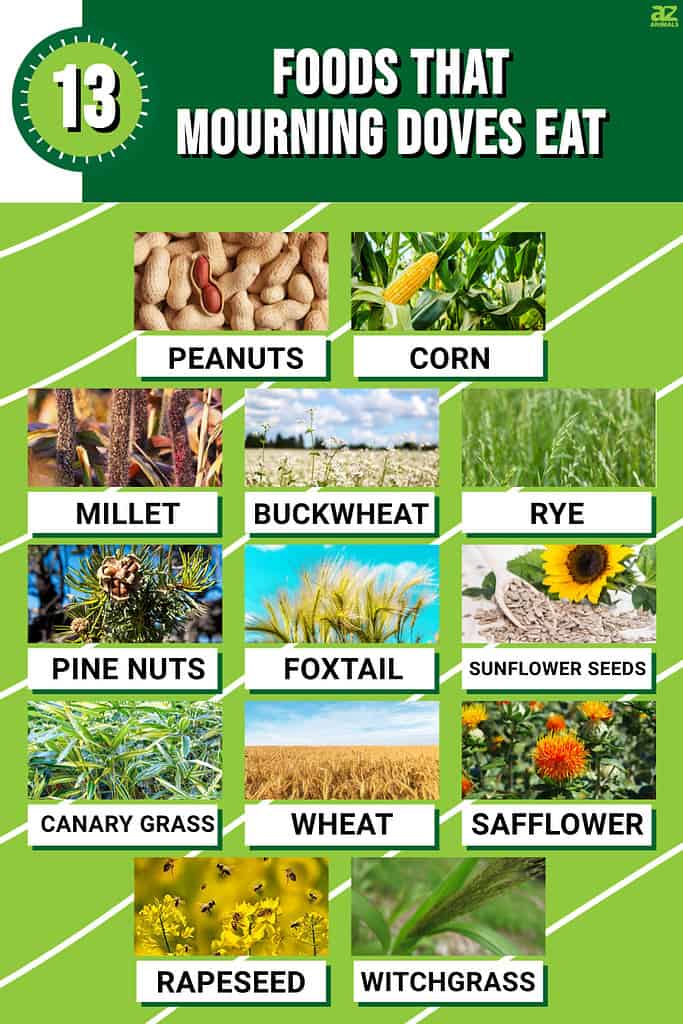
What Foods Do Mourning Doves Eat?
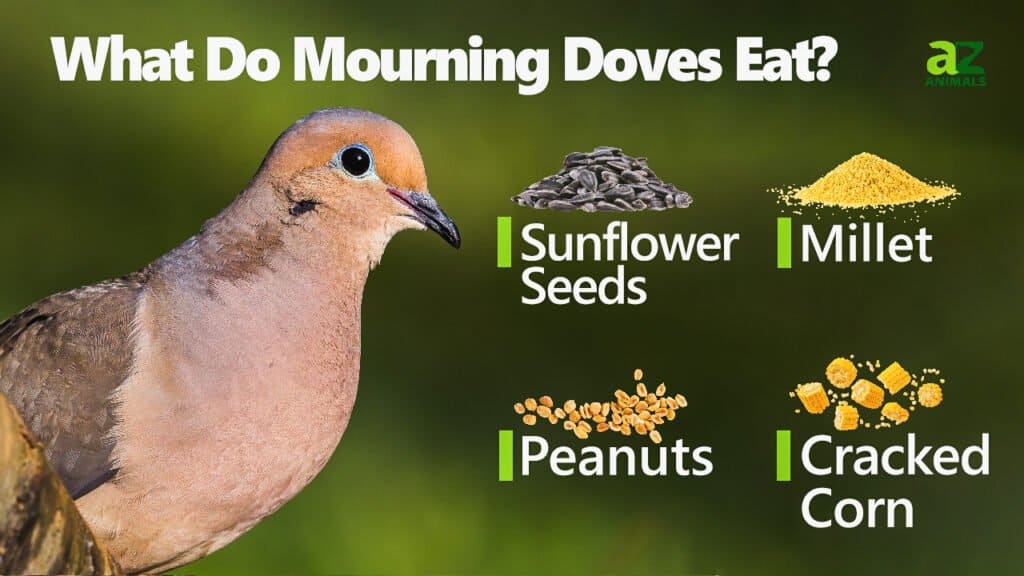
Mourning doves eat seeds since they are granivores, preferring seeds to any other foods. They will also consume grains, some fruits, herbs, and wild grasses. They prefer to eat foods that are on the ground that are easy to obtain. They’re also very opportunistic eaters, consuming some foods that are only seasonally available.
Mourning doves prefer to linger in areas where there is a greater level of food diversity. Remember, these birds mate for life, so they need consistent food for each member of the pair.
A List of Foods Mourning Doves Eat
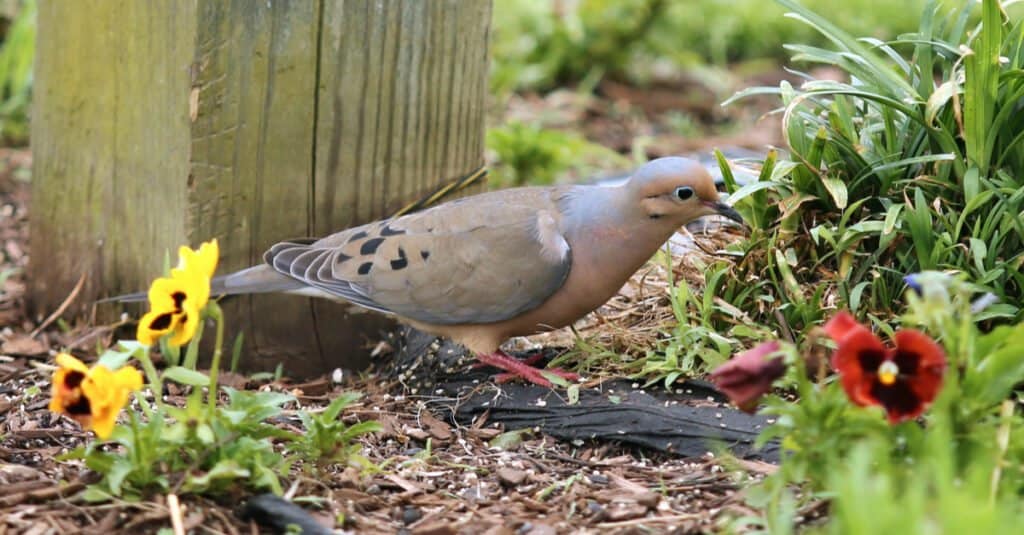
Mourning doves will forage for food on the ground
©Tom Cantaffa/Shutterstock.com
Although mourning doves are granivores and seeds make up almost all their diet, they eat many different foods. Here are many of the specific foods that mourning doves consume regularly:
- Peanuts
- Corn
- Millet
- Buckwheat
- Rye
- Pine nuts
- Foxtail
- Sunflower seeds
- Canary grass
- Wheat
- Safflower
- Rapeseed
- Witchgrass
Interestingly, mourning doves tend to favor sunflower seeds and other foods that they can see without having to scratch the ground for it. Another point of interest is that these birds tend to choose foods based on their size.
For example, studies showed that mourning doves prefer shorter and narrower corn seeds so they have the easiest experience foraging.
Although it is an exceedingly rare occurrence, mourning doves have been observed eating other foods when their favored foods are not plentiful. These birds occasionally eat insects to bolster their diet, but they will almost always prefer to eat seeds.
How Do Mourning Doves Forage for Food?
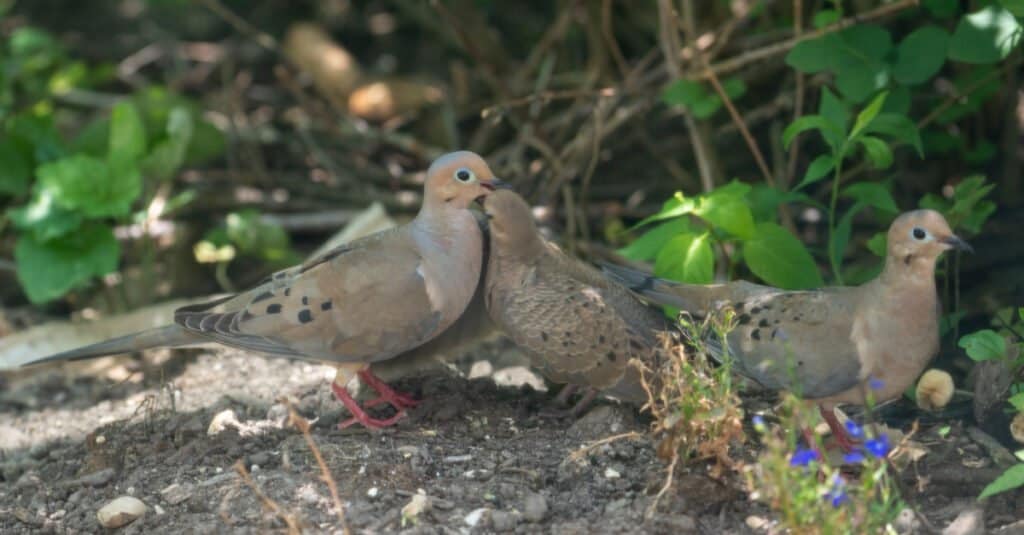
A mourning dove foraging and feeding
©Brooke Bowdren/Shutterstock.com
This species has interesting foraging behaviors. They spend a lot of time on the ground looking for food, but these birds are not known for scratching the earth and trying to find something to eat. These birds prefer to look on the ground and seek directly visible food.
Like some other birds, mourning doves will feed while they’re on the ground, filling their crop. This pouch at the front of their neck can store food and begin the process of digestion. Frequently, mourning doves will fill their crop and then retreat to a safer location where they can digest their food in peace.
Their crop is also where adult birds produce crop milk, a substance fed to the young.
What Foods Do Mourning Doves Eat in the Winter?
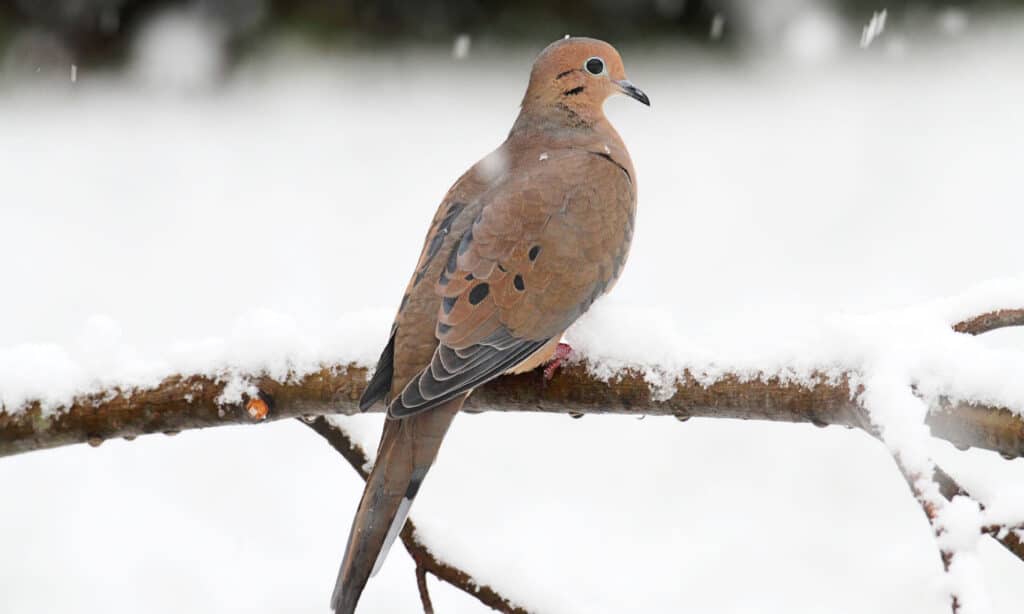
Mourning doves are less selective in the winter
©iStock.com/SteveByland
Mourning doves, like many other birds, start to migrate south in the autumn months. Some of the birds leave for warmer states in the U.S. while others go farther south to Mexico and Central America.
Does their diet change during fall and winter? What do mourning doves eat during these colder months?
During the fall, these birds have been observed eating foxtail millet in southern states, and they also forage around recently harvested cornfields.
In the winter months, mourning doves will continue to forage for their normally desired foods. The migration to warmer climates often supplies them with plentiful foraging opportunities. Not all of these birds migrate, though.
Some birds stay relatively close to their breeding grounds throughout the winter, where they will forage, become less active, and feed on their preferred foods or secondary foods when their first choices not available.
What Do Baby Mourning Doves Eat?
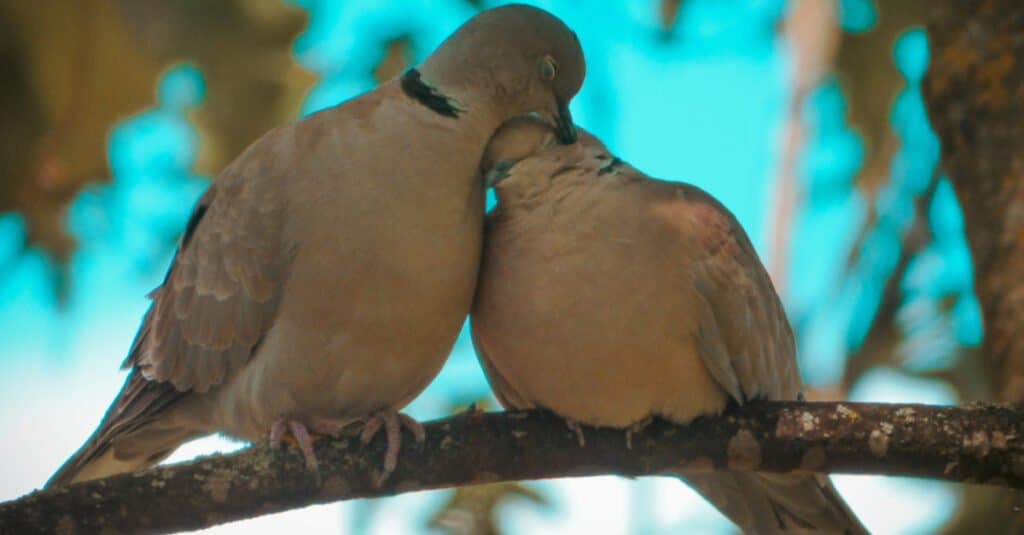
Mourning dove parents forgo seeds for the first weeks of their young’s life
©petritzaa/Shutterstock.com
Baby mourning doves exclusively eat crop milk for the first week of their lives. Both male and female adult birds can make this substance in their crops, the esophageal pouch where they store food and begin the process of digestion.
Crop milk is made from cells of the crop lining, providing necessary protein and fats to the baby birds. While producing and feeding their babies, the birds cannot eat seeds because the young birds are not prepared to digest them.
In the second and third weeks of life, baby birds eat partially digested seeds from their parents. After that, they are prepared to forage for seeds on their own.
Mourning Dove Predators
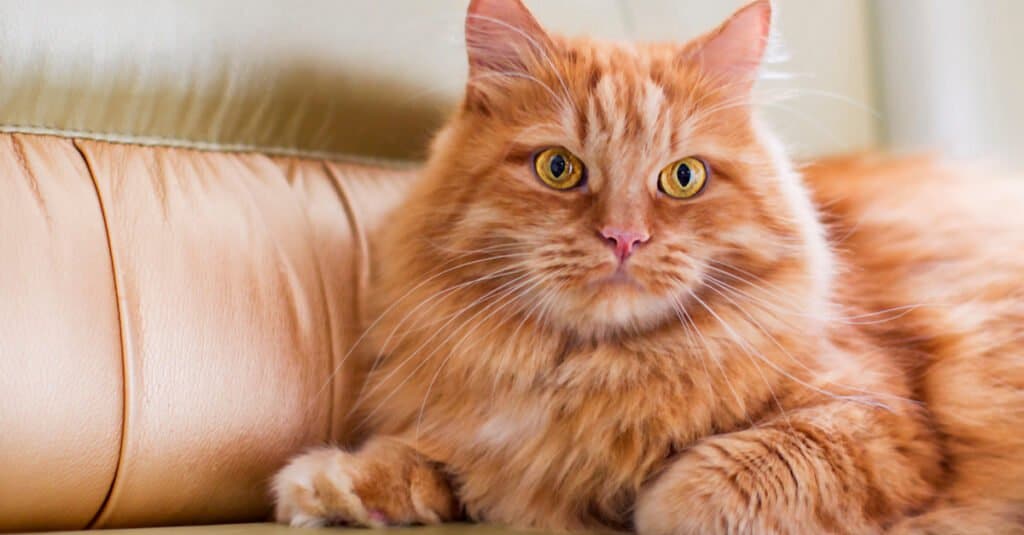
Domestic cats will hunt birds for sport
©iStock.com/FediushkinaElena
Unlike other birds that will eat out of hanging feeders or catch their food and take off, the mourning dove eats while rather stationary on the ground. While foraging, these birds are in tremendous danger from their predators.
Among the most common predators are:
- Domesticated cats
- Diurnal birds of prey like hawks and falcons
- Snakes
- Racoons
- Possums
These creatures prey upon the mourning doves, especially the young ones. If you see these birds in your yard, try to keep your pet cats inside so the birds can feed in peace.
Mourning doves eat seeds from various plants throughout the year, and you might see one eating fruit or a stray insect from time to time. They are tremendous foragers who take what is available without digging through the dirt, even if it puts them in danger from some common predators.
Their broad range of suitable foods, even if they’re mostly seeds, makes them capable of living in many different locations throughout the Western Hemisphere. If you look and listen for them, the chances are good that you will discover this species near you.
Summary of 13 Foods That Mourning Doves Eat
| Number | Food Mourning Doves Eat |
|---|---|
| 1 | Peanuts |
| 2 | Corn |
| 3 | Millet |
| 4 | Buckwheat |
| 5 | Rye |
| 6 | Pine Nuts |
| 7 | Foxtail |
| 8 | Sunflower Seeds |
| 9 | Canary Grass |
| 10 | Wheat |
| 11 | Safflower |
| 12 | Rapeseed |
| 13 | Witchgrass |
Do Mourning Doves Need Water?
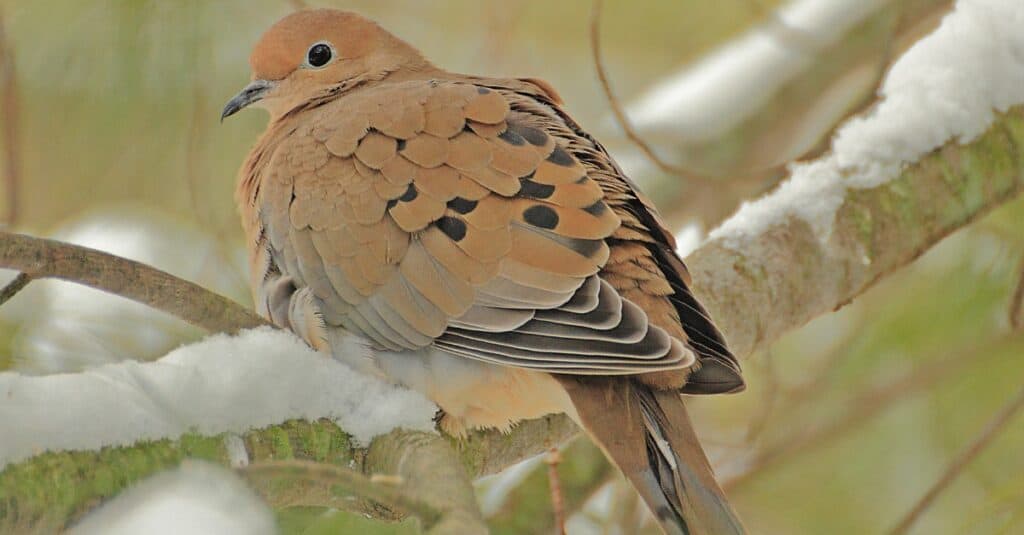
Mourning doves are also known as turtle doves and are commonly found in pairs.
©iStock.com/gregvandeleest
All animals that belong to the family Columbidae consume liquids by sucking them through their bills, unlike other species that will fill their bills with water and let it trickle down their throats. Mourning doves (Zenaida macroura) require more water than other birds and don’t fare well if they don’t intake the proper amount on a daily basis, which makes them susceptible to dehydration. These doves quite often obtain the amount they need through their diets and only need to drink a few times each day, where they are able to get the proper hydration fairly quickly, in around 20 seconds.
Their preferred locations for drinking are areas of water that aren’t surrounded by too much plant life, and are closer to ground level, like bird baths, water fountains, ponds, and even pools. Should you have a pet mourning dove, it is very important to make sure they have regular access to clean water.
The photo featured at the top of this post is © iStock.com/gregvandeleest
Thank you for reading! Have some feedback for us? Contact the AZ Animals editorial team.






